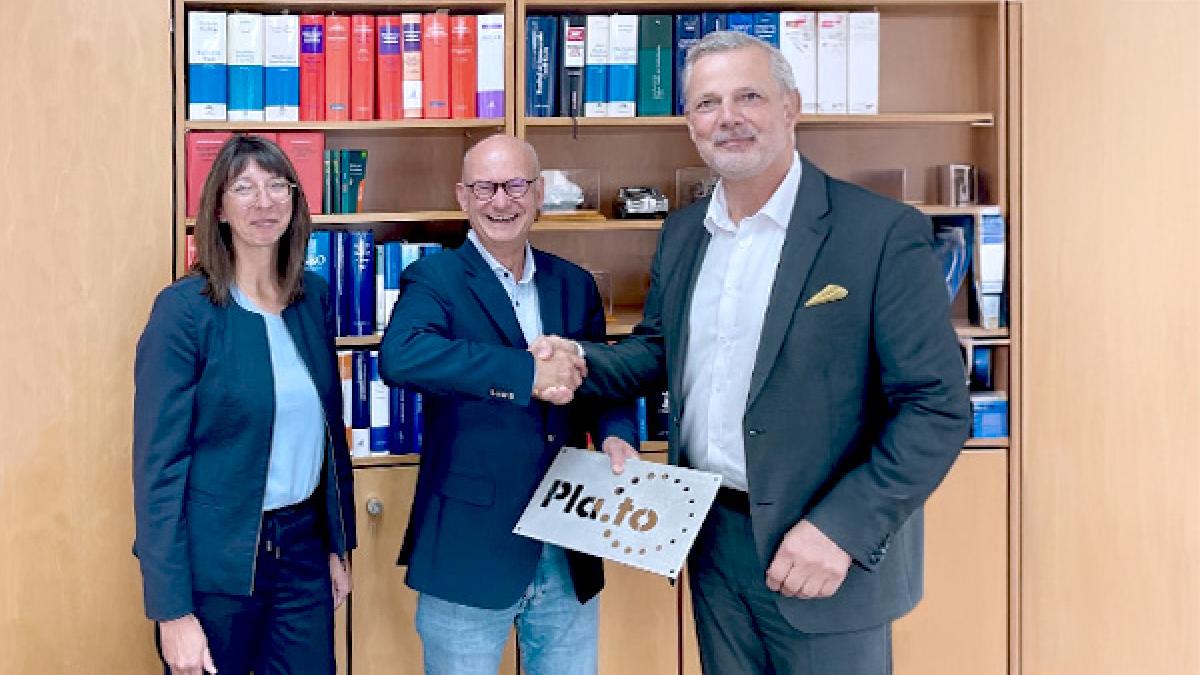“We recycle what many others fail to do”, says Franz-Xaver Hintermayr, Managing Director of KVZ Hintermayr. Moulded parts, castings, foams, plastic film, nonwovens, purgings (post-industrial waste)… the list is long. “Our spectrum ranges from very compact, rock-hard plastics to lightweight, large-volume components”. The thermoplastic materials we shred are often reinforced with fillers or firmly bonded to metal or paper. “Our customer base includes film manufacturers, for example, and injection moulders. They send us their waste material and we process it, enabling them to feed it back into their production – we close the loop, so to speak. We also supply compounders who add additives to the material and refine it”.
Franz-Xaver Hintermayr is an engineer and the second-generation owner of the recycling company, which he runs with his brothers, Karl-Friedrich and Veit-Kilian. Every year, the family business supplies the secondary raw materials market with almost 6,000 tons of high-quality regrind materials and regranulates that are mainly delivered to Germany and neighbouring countries such as Italy, Austria, the Netherlands and Spain.
An early form of recycling
The story all began in the mid-1980s when their father Karl Hintermayr built a large shed for almost 800 cattle in Gersthofen near Augsburg. The master farmer actually wanted to emigrate permanently to Canada in the 1970s, but he only stayed there for six months. During this time, he used the experience he gained on a farm to found his own cattle breeding business.
“We wanted to sell high-quality beef”, he recalls. To feed the animals, he used by-products from neighbouring farms, such as potato peelings and beet pulp, which is a waste product from sugar production. He reminisces: “We reused a lot of leftovers – that was an early form of recycling, you could say. “Even back then, we were already ahead of our time”.
Initially, business was very good, but prices collapsed with the opening up of the Eastern bloc – and when the BSE epidemic spread to Germany and many cattle died, the business soon was no longer profitable. Karl Hintermayr had to rethink things. “I liked the idea of recycling”, says the company founder. “So in 2000, we emptied the big cowshed and converted it into a hall with two floors. We put a shredder and a granulator inside – and that laid the foundations for our new company”.
With know-how to more growth
Franz-Xaver Hintermayr explains: “As the years passed, we realised that if we couldn’t process certain plastics, we’d soon be out of business”. He decided then to study plastics and rubber technology to inject specialist knowledge into the company. This know-how enabled him to drive the company forward.
Since 2008, there has been a second company site in Wertingen, just 20 kilometres away from the converted cattle farm – and that’s where KVZ Hintermayr installed its two extruder lines. The material must be shredded before it’s fed to the extruders. Franz-Xaver Hintermayr explains: “For films and lightweight expanded polypropylene (EPP), we used a single-shaft shredder combined with a granulator, and another shredder for hard plastics and polystyrene”.
To increase throughput, the company needed a new extruder. The recycler has relied on an established Austrian manufacturer of extruder technology for years – and the Hintermayr brothers quickly found what they were looking for at his IFAT 2024 trade show stand in Munich. However, they also needed a suitable shredder, which could keep pace with the new extruder and also be easily integrated into the shredding system. The VIZ 1700 from Vecoplan caught their eye at the trade fair and sparked their immediate interest as they were curious about the machine’s new design.
Vecoplan, headquartered in Bad Marienberg in the Westerwald region of Germany, develops plants that shred, convey, separate, and store wood, biomass, plastics, paper as well as household and commercial waste. “We don’t just put a machine down in front of our customers’ doors and leave it there. Our portfolio includes comprehensive project management, installation and commissioning, as well as a full service package,” explains Bastian Wienen, Regional Sales Manager at Vecoplan. He invited KVZ Hintermayr to the Vecoplan Technikum in Bad Marienberg. “Our new shredder had to be able to shred and process different materials”, explains Veit-Kilian Hintermayr. “The new VIZ reacts very flexibly to this enormous mix of materials”. Another important factor is that the machine must function reliably, otherwise the entire production line will come to a standstill. Vecoplan delivered the plant in December 2024. Since the new extrusion line was commissioned, the shredder has been running in a three-shift operation.
Flexible – with low operating costs
In the hall in Wertingen, an employee uses a telescopic loader to tip the materials into the shredder. The large cutting chamber and innovative rotor geometry produce a homogeneous mixture, which a screw conveyor transports to a suction blower. From there it goes to a storage silo and is finally fed into the extruder. “Thanks to its range of versatile features, the VIZ can be used in a variety of ways. It combines the properties of a classic single-shaft shredder and a grinder”, explains Franz-Xaver Hintermayr. “Depending on the actual operating conditions, the VIZ has a maximum throughput of around 2,000 kg for this area of application”, says Wienen. “It has a high level of availability, its low operating costs and maximum throughput are impressive and it can process a wide range of different plastics”. During the development of the VIZ series, Vecoplan engineers focused on creating a flexible cutting geometry. The company can adapt the system’s performance to input and output requirements through individual rotor and blade configurations and the choice of a relevant screen. The performance can be precisely matched to the interface.
An impressive drive
KVZ Hintermayr was particularly impressed by the HiTorc drive with its strong startup phase and high torque. The elimination of mechanical drive elements such as belt and gear drives and flywheels and clutches, increases machine efficiency by up to 25%. Energy savings of up to 40% are possible compared to other electromechanical drives – and for hydraulic drives, that figure can be as high as 60%. This significantly reduces electricity costs and CO2 emissions. “Thanks to the range of speeds available, the drive can be infinitely adjusted to the best possible operating speed for a wide variety of input materials – a slow speed for polystyrene bales, for example, and a faster speed for filaments”, explains Franz-Xaver Hintermayr. What’s more, even if there are only a few foreign materials in the machine, a shock sensor system detects them immediately and the drive responds instantly, virtually ruling out consequential damage. All the maintenance work can also be carried out ergonomically thanks to the hydraulically operated, upwards-pivoting bottom flap and the cutting gap can be precisely and safely set from outside the machine.
Thanks to the powerful motor and V-rotor arrangement, the machine always starts up reliably, reducing downtime and the unnecessary emptying of loads. Veit-Kilian Hintermayr adds, “We can also change many parameters ourselves and save them as a recipe”. The new shredder is equipped with the Vecoplan Smart Center (VSC) as standard. The intuitive VSC.control operating panel is integrated into this powerful digitalisation concept and serves as a communication medium for the modern control system and direct connection with Vecoplan. The machines are networked with the help of the VSC.connect, which provides access to additional online services, such as remote support, key performance indicators, and a media database containing self-service tutorials. A camera installed in the shredder allows sensitive areas to be monitored at any time – conveniently from the sofa at home or via tablets on the telescopic loader. “We can intervene immediately if necessary”, says Franz-Xaver Hintermayr.
A hydraulic linear ram pushes the material – fully automatically and load-dependent – into the working area of the rotor. This process can also be programmed individually on request. The inclined ram and the very slow-turning rotor allow the machine to be emptied efficiently, which saves time when changing materials.
Franz-Xaver Hintermayr emphasises: “With Vecoplan, we have a partner who’s always dependable, even when things get complicated – and that’s exactly what our customers appreciate about us”.

The converted cattle farm of KVZ Hintermayr in Gersthofen.

The new VIZ from Vecoplan: flexible, low-maintenance and energy-efficient.
The powerful motor and the V-rotor arrangement mean that the machine always starts up, reducing downtimes and the unnecessary emptying of loads.
The HiTorc – compared to other electromechanical drives, it saves a significant amount of energy.
The screw conveyor, also supplied by Vecoplan, transports the shredded material to a suction blower, which transfers it to a storage silo.
The shredder is equipped with the powerful Vecoplan Smart Center (VSC) digitalisation concept as standard.

Flexibility is one of KVZ Hintermayr’s key characteristics, because the materials to be processed vary greatly. Pressed polystyrene bales are just as much a part of the company’s repertoire as…
...semi-finished products from plastics production...
...bale- and roll forms…
…and even waste items from refrigerator production.

The homogenised output material after shredding.
(from left to right): Founder Karl Hintermayr, who handed the company over to his sons Franz-Xaver and Veit-Killian, with Bastian Wienen from Vecoplan.


